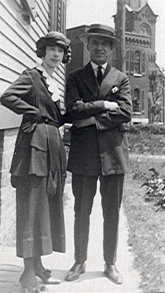
St. Louis immigrant Robert Kunstel, Jr. and his wife Elsie Agnes Vieth, circa 1920.
Ellis Island
Ellis Island was the principal federal immigration station in the United States from 1892 to 1954. More than 12 million immigrants were processed here. Over time, the immigration station spread over 3 connected islands with numerous structures including a hospital and contagious disease wards. It is estimated that over 40 percent of all citizens can trace their ancestry to those who came through Ellis Island. In its early years, when the greatest number of immigrants entered the country, Ellis Island mirrored the nation's generous additude and open door policy.
The opening of Ellis Island began a new era of restriction in the history of immigration. Here, the inspectors determined each newcomer's eligibility to land according to United States law. For the vast majority of immigrants, Ellis Island meant three to five hours of waiting for a brief medical and legal examination. For others, it meant a longer stay with additional testing or a legal hearing. For an unfortunate 2 percent, it meant exclusion and a return trip to the homeland.
After being inspected and receiving permission to leave the island, immigrants could make travel arrangements to their final destinations.
Only one third of the immigrants who came to the United States through Ellis Island stayed in New York City. The majority scattered to all points across the country via a railroad that crisscrossed the entire continent and offered easy access to all of America's major cities. After immigrants had arranged their travel plans they were given tags to pin to their hats or coats. The tags showed the railroad conductors what lines the immigrants were travelling and what connections to make to reach their destinations.
Compiled from National Park Service information, Ellis Island Museum. In 1893, the United States required steamship companies to record in manifests the vital statistics of all passengers. The manifest sheets listed the names of the passengers and their answers to a series of questions regarding nationality, marital status, destination, occupation and other personal information. When a ship arrived in New York, the manifests were turned over to Ellis Island Inspectors and used as a basis for cross-examining each immigrant.
The inspector's prime task was to question new arrivals to verify information already recorded in the ships' manifests; however, scores of immigrants contend that in the process their names were changed or simplified.
In 1893, the United States required steamship companies to record in manifests the vital statistics of all passengers. The manifest sheets listed the names of the passengers and their answers to a series of questions regarding nationality, marital status, destination, occupation and other personal information. When a ship arrived in New York, the manifests were turned over to Ellis Island Inspectors and used as a basis for cross-examining each immigrant.
The inspector's prime task was to question new arrivals to verify information already recorded in the ships' manifests; however, scores of immigrants contend that in the process their names were changed or simplified.
![]()
This page is maintained by scubadog.geo. Please email me if you have additonal info or would like more details concerning Kunstel surname history in the United States and Europe.